Russia's modern IFV/APC
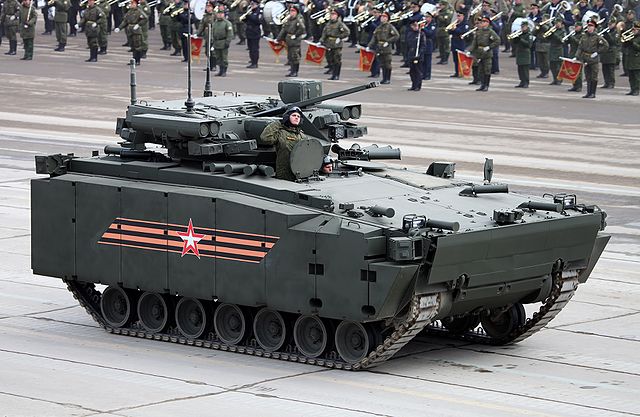
The Kurganets-25 (Курганец-25) is a multirole platform rated for 25 ton, designed to be amphibious, NBC protected and highly modular. The same platform is not only usable as an infantry fighting vehicle and armored personnel carrier but it is also derivative specialized models to replace the BMP, BMD, MT-LB and other legacy types. Given its ambitious target, the Kurganets-25 not only have a modular interior, but also modular armor, mission-tailored. First public presentation was the Red Square May 2015 victory parade but initially with its turret and main armament shrouded in rehearsals with pre-production starting by 2016, certifications still going on in 2020-2023 with extensive trials and some changes notably on the chassis.
Development
First specifications for the vehicle were published in 2011 by the Russian Ministry of Defense. It was to replace the BMP-3, but later variants should replace all BMPs in the inventory, which design is sometimes dating back the 1950s. The Kurganets-25 thus was first planned as direct suceessor to the BMP-3 IFV or to be a Russian equivalent to M2 Bradley or British Warrior. Notably it needed to adress the issues of previous BMP-3s, such as a cramped crew compartment and cramped exit.Its platorm is essentially the "Armata Universal Combat Platform". Being lighter than the T-15 Armata heavy IFV or wheeled VPK-7829 Bumerang is should have better performances. From the basic design were developed two widly derived types, the infantry fighting vehicle (better armament traded with a 6-7 troop capacity) and more lightly armed APC (8 troops). Also were planned an armored ambulance, a mortar carrier, anti-tank, reconnaissance, command and both an armored engineering and recovery vehicles. Development history is foggy, and the vehicle is currently manufactured by Kurganmashzavod, which alread produced the BMP-1, BMP-2 and BMP-3.
The program started in 2011 but held in great secrecy. One of the goal was maximizing commonality between platforms, notably the IFV/AP but also the T-15 heavy IFV and Boomerange wheeled IFV/APC as well as future variants menagerie. Instead of low profile soviet legacy cold war designs, they integrated for the first time a higher floor, to better absorb mine/IED punishement, and rather oriented for mounted combat instead of just "troop carrying". The current plan is to have the T-15 integrated into T-14 main battle tanks in armored formations, while the Kurganets-25 would fill mechanized units. However so far, nothing contretized despite mass production was announced as early as 2016, after a 2015 public reveal.
Later a SPAAG version with a 57 mm autocannon was planned, as well as a 125 mm self propelled gun, and an ARV is in development, equipped wth a crane, winch, armed with a 12.7mm (0.5 in) heavy machine gun. So far no photo of even graphic surfaced of these. The APC crew is decribed as having as many as 3+8 passengers, the latter seated however without firing ports or personal hatches to fight from within the vehicle. Main reason is technologic, with the new APS which detect and fires automatically against any threats. The Israeli Merkava Mk4 also uses such blast deflectors, which protects the tank commander. The other reason is simpler NBC protection. Crew access is via a single rear door, which does not includes gasoline or any hazard and there is probably a trap below if the vehicle toppled over.
Detailed Design
Powerplant and Mobility
The Kurganets-25 weighs 25 tonnes, allowing it to be amphibious, albeit tactical transport options are few. Based on an unknown 800 hp engine. Early models were said to be equipped with either the 17-liter, 510 hp ChTZ-Uraltrac 2V06 opposite engine or the YaMZ-780 inline engine (two turbochargers) for 750 hp. It is likely a version of the latter which is boosted to 800 hp and use for it and the Boomerang added to a 6-speed automatic gearbox. The driverain comprises seven doubled roadwheels, rubberized, of the standard type used on all tracked vehicles including SPGs and the T-90 and T-14 Armata. They rests on sets of torsion bars, with shock absorbers on all axles since they has a hydropneumatic suspension with variable ground clearance. There are four return rollers as shown in the rare photos of the chassis without armour. They are indeed hidden behind the side armour, which goes down to 1/3 of the roadwheels height. The latter runs on single-pin tracks (see later).Top speed is 80 km/h on land, 10 km/h on water. It is front-mounted to free the rear space for troops in both the IFV and APC which only have a difference of two seats. This enables a power/weight of 32 hp/tonne. The vehicles are using Torsion bar suspension, and steel tracks fitted with rubber pads (6) to reduce ground pressure and damage on roads. When travelling in water the nose wave breaker is raised while water jets are activated, also used for steering. Range is estimated around 500 km with capabilities of overcoming a 60% slope, a 40% side slope, 0.7 m vertical step and gap a 1.8 m trench, but these are all estimations.
Protection, active and passive
For the passive protection, little is available as data is secret. We can assume the basic hull able to resist 12.7 mm rounds all around, with extra protection on the front perhaps against 25 mm atutocannon rounds, and the trime vane. The turret is unmanned and the while crew of three is located below and in front in an armoured capsule, while six men seats aft of the turret in the rear compartment. The taller hull also is probably given a "V" type protection belly deflector, while seats are likely suspended. Some sources says that there are roof hatches for firing and emergency exit.But the most important passive component is the set of extra armour, with also participates with the buoyancy of the vehicle: These sets of add-on armor blocks comprises eight main modules each sides, bolted on the hull, which filling is unknown. They are likely able to defeat ATGMs, APFSDS and HEAT/HEASH rounds as well, offering the equivalent of perhaps 2000 mm of RHA. They provide also additional buoyancy and stability on water. There is also a state of the art NBC protection system with overpressure, full sealing, and automatic extinguishers in the fighting, troop, and engine compartment, fully automated. The ready-ammunition in the turret is also provided with a deflector and flash protection. More ammunitions are likely stored inside the hull.
The Kurganets-25 IFV has 360-degree coverage from its active protection, between sensors, cameras and immediate response via countermeasures and the system launcher tubes. This is basically the same APS but reduced compared to the T-14/T-15, attached on top of the hull. These is a two-part projectile detection system with detectors around the hull and turret. The APC variant, has even a scaled down APS system only on its turret. The active protection system ‘soft kill’ elements comprises 16 large tubes and four sensors connected to the automated Drozd-2 active protection system or Afghanit ‘hard kill’ system. There is also LED spotlight acting as a decoy against 2nd-generation ATGMs on the turret, a slimed-down version of the T-90's Shtora.
The cameras covers a full 360 degrees, covering wide fields of view or placed in the armor so see crawling infantry around. The side-looking cameras basically looks through armor gaps. According to the Manufacturer co-CEO Albert Bakov, the vehicles uses a console roughly similar to a PlayStation gamepad to ease new recruits.
Armament and configuration as IFV
The Kurganets-25 IFV features the Bumerang-BM remote control turret composed of a 2A42 30 mm autocannon and coaxial 7.62 mm coaxial PKT machine gun, plus on the sides, two Kornet-EM anti-tank guided missiles. In alternative the AU-220M Baikal remote weapon station with a 57 mm BM-57 autocannon/7.62 mm PKMT machine gun could also be mounted. This KBP EPOCH turret became a standard in all recent Russian AFVs such as the Armata T-15 and Boomerang, and as for the T14 it is unmanned. The 2A42 cannon is provided with 500 rounds including HE and AP rounds, to be precise 160 armor-piercing and 340 high-explosive fragmentation rounds. There is also a new fire control system automatically searching for targets in passive and active modes and a thermal imager for the gunner.The coaxial PKT is a "classic". This reliable but elderly 7.62 mm coaxial machine gun is probably supplied to c2000 rounds, with tracers.
The four 9M133 Kornet-EM guided missiles, two canister per side, are a powerful addition to the vehicle's panoply. They are usable against MBTs with 1,200 (E) penetration after ERA with Tandem HEAT, Thermobaric or HEAT 4.6 kg (10 lb) Warhead with impact fuze. These are propelled by a safe solid-fuel rocket with a range up to 8,000 m against tanks or 10,000 m in a ballistic ground use. The guidance is using laser beam riding.
For these, the turret includes two electro-optical target acquisition and missile guidance systems. There is also a meteorological mast for extra data and other sensors.
Armament and configuration as APC
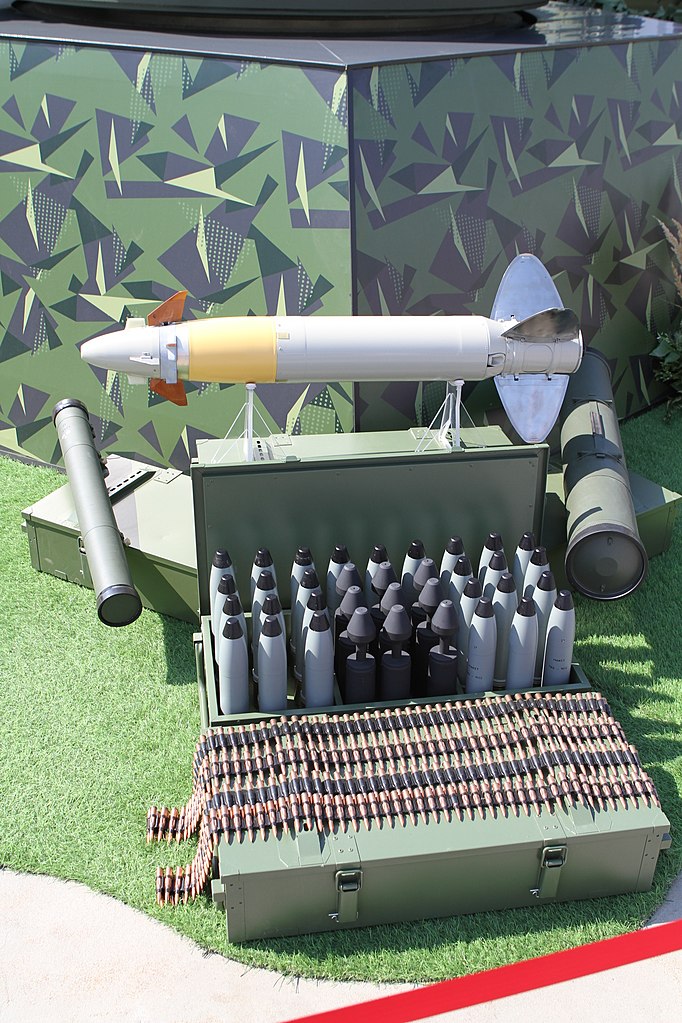
Kurganets 25 at Amtiya 2022
The Kurganets-25 APC variant has a 12.7 mm MG RWS instead of the Bumerang-BM turret. The protection as said above is much degraded (not passive buy active) with the lightest ‘hard kill’ variant of all new vehicles presented in 2015. The armour package however is the same as the IFV, but there are far less smoke dischargers.
Variants
Armored Recovery Vehicle (crane, winch, 12.7mm heavy machine gun)Armored Ambulance (perhaps 4 strechers, 4 seated injured personal and medical staff)
82mm Vasilek Mortar Carrier, probably with open rear compartment in which the gun is mounted, or in turret.
Anti-tank Vehicle (Probably with an advanced version of the Kornet or heavier ATGM, automated reload system.
Reconnaissance Vehicle: Announced but not further explanation if its a chemical or classic recon vehicle.
Command Vehicle: Again, proposed by no info available.
Armored Engineering Vehicle: Also announced, no info so far.
Self Propelled Anti-Aircraft Gun (SPAAG), perhaps with the Tunguska-M turret.
Self Propelled Gun (125mm), with turret, not yet defined. Could be remote and automated, making it lighter.
Current Status
The Kurganets 25 is a good demonstration of the general keptoclatric nature of the regime at all echelons. Delays accumulated despite the 2016 production announcement. In 2017 there was a public announcement that the vehicle was "still being tested by the manufacturer". Numerous problems related to design but also production, as well as procurement of foreign components are probably the reasons, but by 2022 it is not in service and far from full rate production, just as all nearly the major new armoured vehicles announced in 2015. The Tractor Plants was in fact close because of bankruptcy with the former general director accused of embezzling funds allocated for its development as two other officials, all arrested.Given the fact the base vehicle is not yet operational it is dubious that any variants would be before years. The current war is draining resources which are probably starving these 2015 programmes. Needless to say none saw action, at least officially in Ukraine recently.
specifications | |
| Dimensions (L-w-h) | circa 7.2 m x 4 m x 3.2 m |
| Total weight, battle ready | 25 tonnes (28 short tons) |
| Crew | 3+8 |
| Propulsion | diesel 450-800 hp |
| Speed (land/water) | 80/10 kph |
| Range (on flat) | 500 km |
| Armament | 30 mm, 4x Kornet-M ATGM coax 7.62 mm |
| Armor | 13mm AP proof + Modular blocs + Active Drozd-2/Afghanit |
| Total production | c10 prototypes/pre-prod vehicles |
Illustrations
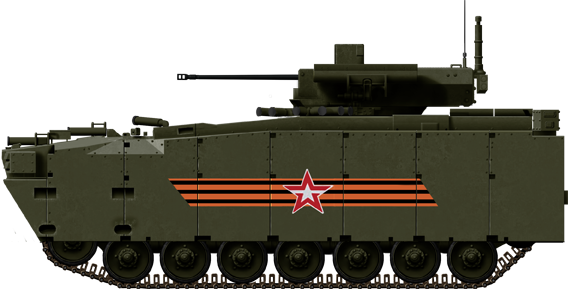
Kurganets-25 IFV (Object 693)
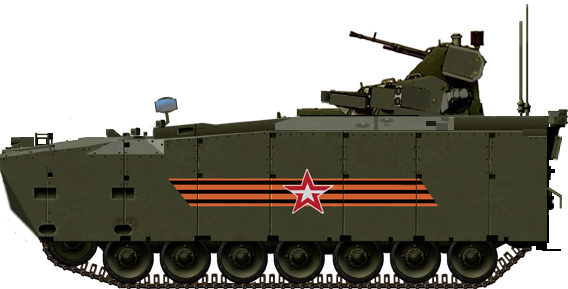
Kurganets-25 APC (Object 695)
Gallery
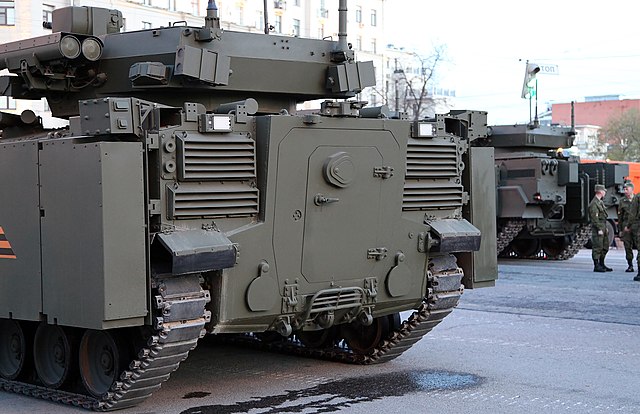
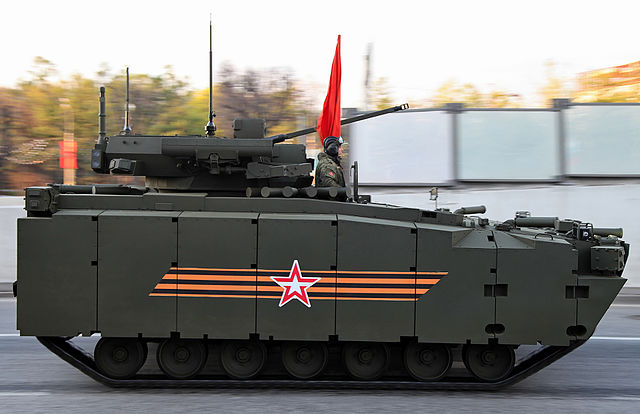
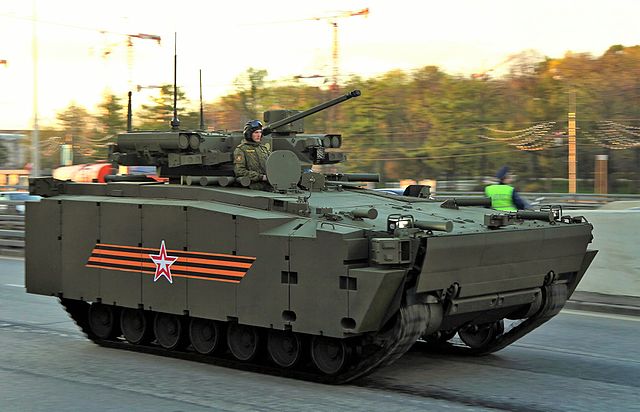
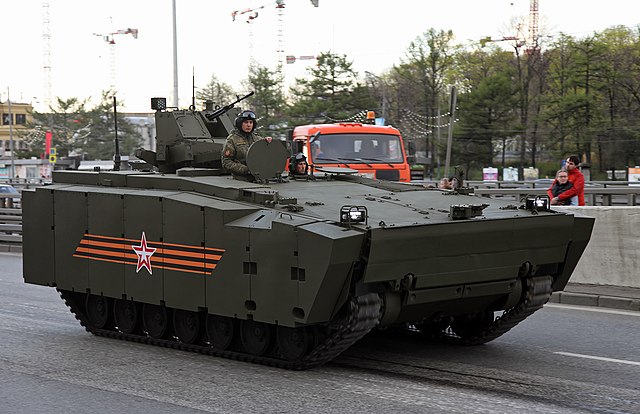
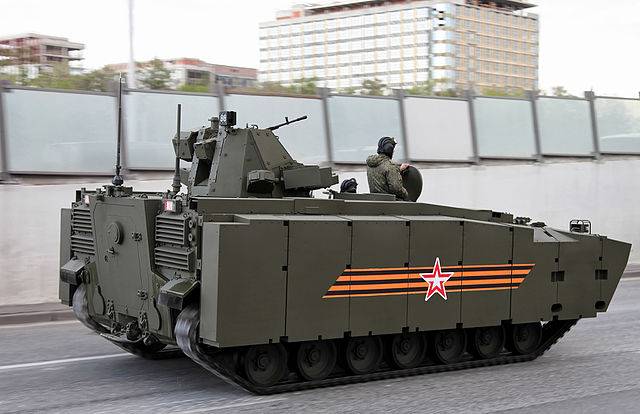
Photos of the vehicle, both IFV and APC at rehseasals - Vitaly Kuzmin





Read More
armyrecognition.commilitarytoday.com/
army-technology.com
nationalinterest.org
en.topwar.ru/
defense-update.com
militaryfactory.com
ru.wikipedia.org
tanknutdave.com
globalsecurity.org
odin.tradoc.army.mil
thaimilitaryandasianregion.wordpress.com
Russia's Future Infantry Fighting Vehicle Kurganets-25 undergoes Chassis Overhaul
Russian Kurganets-25 Infantry Vehicle Serial Production To Begin In 2019
Russia to Begin BMP Replacement in 2021
forbes.com
21stcenturyasianarmsrace.com
Model kits on scalemates
Videos

Modern Tanks
Modern MBTs posters

Denel Bagder (2018)

Type 16 MCV (2016)

Gepard 1A2 last rounds 2011

SANDF

Russian AFVs

Main Battle Tanks
